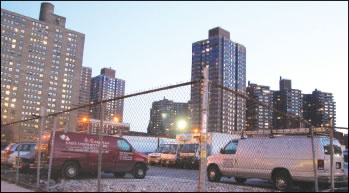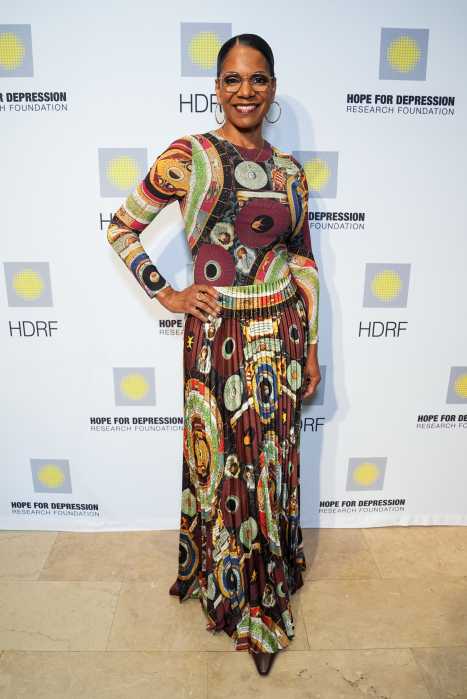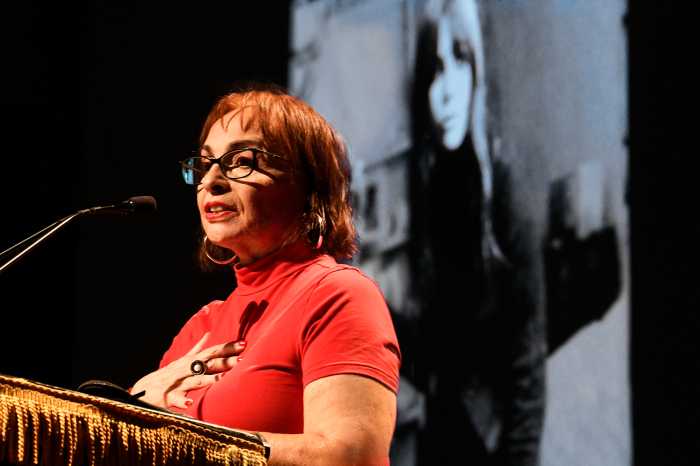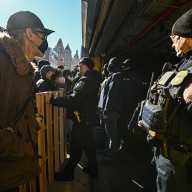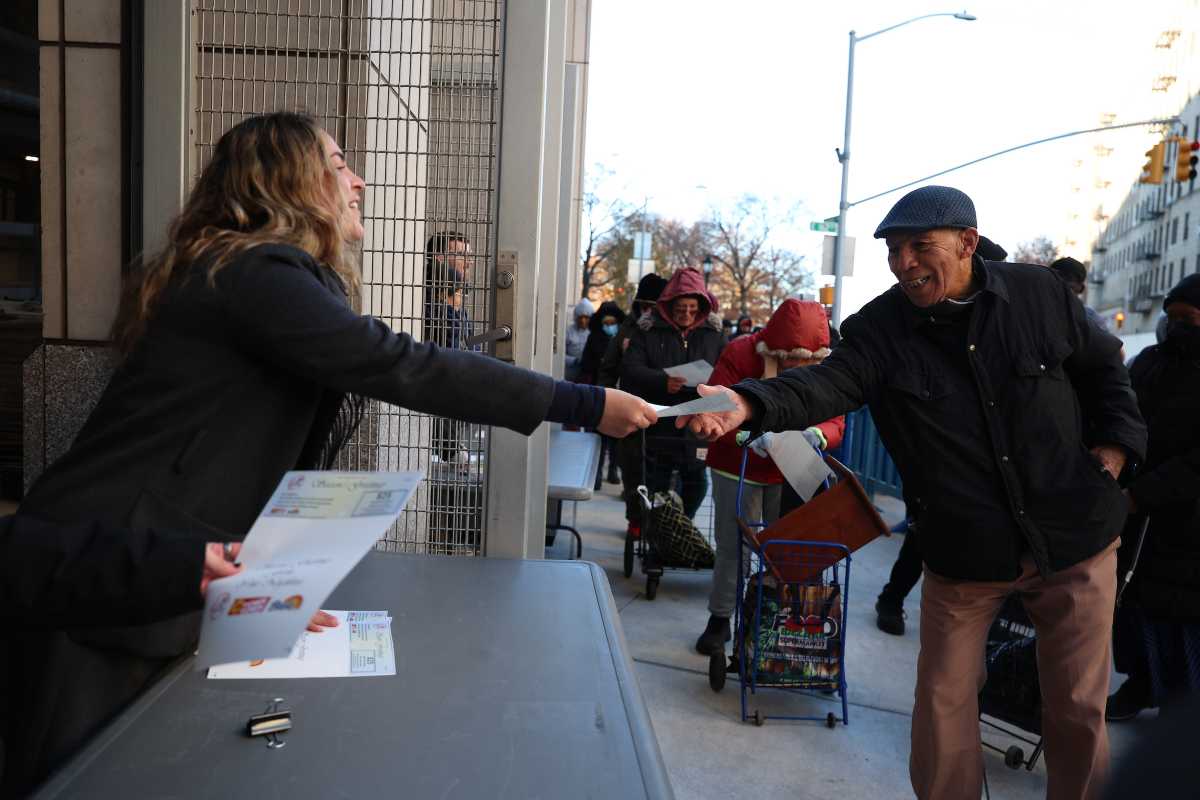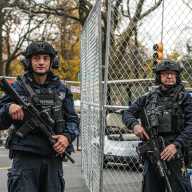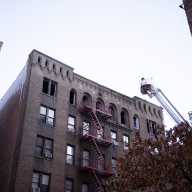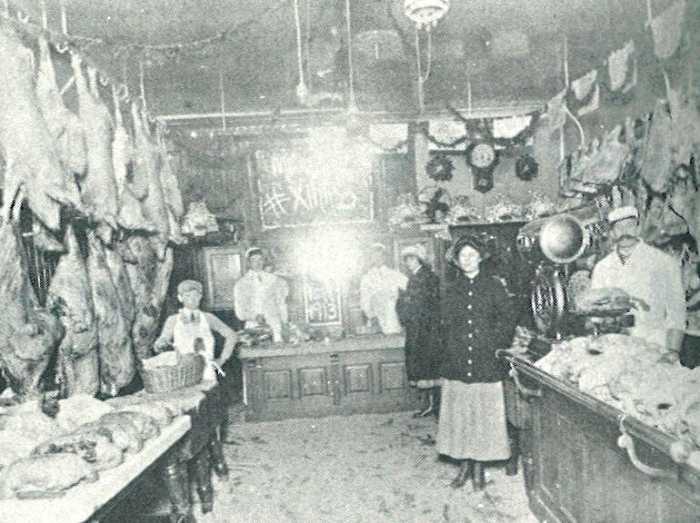By Joel Feingold
On Monday, a Community Board 3 committee may vote on guidelines for the redevelopment of the Seward Park Urban Renewal Area (SPURA) — the long-derelict blocks along Delancey, Broome and Grand Sts. at the lip of the Williamsburg Bridge. In shaping the final language of these guidelines, this committee can choose to close the chapter on a 43-year aberration in the Lower East Side’s history: The notion that a racially integrated, working-class district is harmful to society in general and property values in particular. This notion allowed the crime of urban renewal to occur in the first place; this false notion must not be allowed to taint prospects for the just redevelopment of the site.
Good Old Lower East Side (GOLES), a membership-based housing and economic justice organization founded in 1977, has been deeply involved in Community Board 3’s deliberations since they began in late 2008. Today, we announce our position on the crucial questions the community board will decide — regardless of whether the final vote on these questions is indeed Monday, or whether it is held later this spring.
When SPURA was razed in 1967, the city evicted 1,852 families, the majority people of color. No one who lived there was rich. At most, 1,244 units were built on the site: 360 apartments in the Seward Park Extension (New York City Housing Authority); 600 in the Grand Street Guild (Section 8 with Church backing); 156 in Hong Ning Plaza (Chinese-American Planning Council); and 128 in the senior development at 15-17 Willett St. (U.J.C. Bialystoker).
Even in the hard numbers, insufficient replacement housing for the 1,852 displaced families left a gap of 608 units in the affordable housing stock on the site. The current guidelines project 800 to roughly 1,000 new units could be built. To replace the 608 low-rent units lost to urban renewal alone, between 61 percent and 76 percent of these new units must be affordable. This threshold of affordability must increase in light of gentrification: the wholesale displacement of the working-class Lower East Side and the privatization of the Grand St. co-operatives, in particular.
For these reasons, GOLES members — including several tenants evicted from the urban renewal area in 1967 — propose that 70 percent of the new units be affordable to low-, moderate- and middle-income families, in addition to seniors.
GOLES members further hold that the city must honor its 1967 promise, a verbal and written pledge: that all former site tenants must have the right to return. As the city put it in a letter to site tenants in the late ’60’s: “All present and former residential tenants of Seward Park Extension [i.e. SPURA] will be given first priority to return to any housing built with this urban renewal area provided they meet certain [i.e. income] qualifications.” This was an unequivocal promise to the displaced, one without an expiration date, and we at GOLES believe the city must honor it.
Finally, because it has been 43 years since the crime of urban renewal, we hold that all children of site tenants — people who might have been eligible for succession to their parents’ leases if sufficient replacement housing had been built in the ’60’s and ’70’s — must also have the right to return.
Our hope and our belief is that the city and the historic opponents of housing on the site will be willing to negotiate in good faith on Monday and in the future, just as we have in the years leading up to Monday’s momentous meeting. We do not insist on having our way, so long as the result is just.
The historic opponents to low- and moderate-income housing on SPURA have one chief argument against building 70 percent affordable housing on the site. This faction has argued that the return of an integrated, working-class community to subsidized, low- and moderate-income housing on these blocks will destabilize the neighborhood and depress property values on Grand St.
The argument is frivolous and distorts the co-operatives’ own proud history. The Seward Park Co-operative itself was built as a limited-equity co-operative, a form of moderate-income housing, subsidized by the State of New York through the Mitchell-Lama program. By the logic of this faction, the co-ops themselves should never have been built — too subsidized, too working class, too many dangerous people in too high a concentration: 100 percent of the development, in fact.
Federal subsidy continues at the Seward Park Co-operative even after the sad privatization of every affordable unit in Co-operative Village. Since the privatization, a few of the old co-operative shareholders have found it difficult to keep pace with hikes in maintenance fees. Assemblymember Sheldon Silver found Section 8 vouchers for these co-operators, and as a housing justice organization, GOLES applauds him for doing so. The vouchers are administered by the city’s public housing authority, NYCHA. If the co-ops could be built as 100 percent affordable housing, and if federal subsidy administered directly by NYCHA continues to be necessary to maintain affordability on Grand St., the argument that subsidized housing on SPURA would undermine property values becomes absurd. The case of the Seward Park Co-operative serves only to demonstrate that the people of this neighborhood cannot afford market-rate housing, which on SPURA would cost $6,000 a month.
Built as a state-subsidized housing project, scattered with Section 8 vouchers to this day, neighbored by several public housing developments and a vast, barren parking lot, units in the Seward Park Co-operative presently sell for $600,000 or more. The property-values argument is frivolous, and at worst, it is a smokescreen for the old “pocket-ghetto” argument advanced in the ’70’s to promote the racial segregation of the housing that was built on the site — and to prevent the further redevelopment of SPURA from that time forward. The Second Circuit Court of Appeals resolutely dismissed this argument in Otero v. NYCHA in 1973, and no version of this argument should be allowed to prevent justice on the site today.
The working families of the Lower East Side, and many of the tenants displaced from the urban renewal area in 1967, are doubled and tripled up in various forms of housing — units we are losing every day. Of course, the old Grand St. shareholders remember what an amazing day it was when they paid $500 down per room to live forever on the Lower East Side. Why deny an experience like this to other Lower East Siders? Does it really matter that much to you if your neighbor happens to make a few thousand dollars less a year than you do?
The city advances a different argument against planning up to 70 percent affordable housing on the site. The Economic Development Corporation has maintained that the “project must pay for itself,” that the number of low- and moderate-income families able to live on this site is hostage to what the market can pay for. In this way, the city’s argument and the opposition’s arguments are mutually reinforcing, but both are disingenuous.
We at GOLES know that there is no shortage of subsidy for this project. In fact, the opposite is true: There is abundant subsidy and financing available at the city level, at the state level, at the federal level and even in private-sector funds for the development of low- and moderate-income housing. Just a few examples:
• There are at least $400 million in New York City’s Housing Development Corporation’s coffers specifically earmarked for bonds to subsidize the development and maintenance of affordable housing. The money is earmarked through 2013.
• The city’s Housing Trust Fund (NYCHTF) can subsidize up to $50,000 per unit — and encourages a greater proportion of low-income units than the bare minimum of 20 percent to reach this level of subsidy.
• The city’s Low-Income Affordable Marketplace Program (LAMP) has subsidized thousands of units throughout the five boroughs in recent years.
• The City Council’s general fund is frequently used to finance less worthy projects — for example, this year’s gift of $2.7 million to the luxury gym Basketball City now attempting to open its doors on public land at Montgomery St. and the F.D.R. Surely, the Council could find some funds to save the Lower East Side.
• Governor Cuomo has just proposed a $100 million competitive grant program for communities developing new models in housing and transportation — SPURA above the Essex-Delancey subway station would be an excellent contender.
• $12 million remains in the Lower Manhtattan Development Corporation’s affordable housing fund.
• The AFL-CIO Housing Investment Trust recently invested $90 million to maintain the affordability of Lands End II, a Section 8 development on Cherry St. — and also poured millions of financing into the Seward Park Co-operative itself.
• Section 202 funds for the construction of senior housing remain abundant at the federal level.
• Bank of America, which owes the American working class for plunging us into this economic crisis, has up to $1 trillion available for the financing of low- and moderate-income housing through 2018.
• This is not to mention the subsidy that might be available if the project were also conceived as a workforce program to train unemployed Lower East Siders in the building trades — the ideal intersection of economic and housing justice, and a unique avenue for subsidy. Workers employed by the Works Progress Administration built First Houses (between E. Second and Third Sts. and Avenue A and First Ave.) on just such a model in the depths of the Great Depression. First Houses was the first public housing built in New York City, and the nation.
There is no shortage of subsidy — and, indeed, justice and rational planning on this site requires it. For the project to even qualify for many of these funds, Community Board 3 must plan an affordable SPURA.
Because this site has languished for more than four decades, because the Lower East Side’s very existence as a working-class community is imperiled, because of the shameful legacy of federally funded and city-executed urban renewal, and because this is the heart of the most famous immigrant neighborhood in the world — SPURA warrants deep subsidy from every level of government and every privately administered affordable housing trust.
It is not, as the city argues, that housing subsidies are best spent in Brownsville because that is where they are needed most. It is rather that housing subsidies are needed equally on the Lower East Side and in Brownsville, perhaps for different reasons, but to the same end: to ensure that working-class people can live decently in New York City.
The city’s agencies can do better on subsidies, and must, because this neighborhood’s housing crisis only gets worse as we continue to bleed rent-stabilized units and other forms of affordable housing. Developing SPURA to benefit working and moderate-income families is a crucial first step in addressing the Lower East Side’s housing crisis — a crisis that drags us all down and takes too much rent money out of all of our pockets.
On Monday, the community board’s committee must weigh these facts. But it also must decide who needs SPURA more: those who’ve benefited from the housing boom and the gentrification of this neighborhood, or those who’ve suffered from it.
GOLES members have been at every Community Board 3 committee meeting for the last 18 months. We’ve organized unprecedented community meetings, taking city-planning tools developed for C.B. 3, translating them into Spanish and Chinese and asking the people who live closest to or on the site what should rise at SPURA.
The result was 93 percent affordable housing, mostly small mom-and-pop stores, schools and living-wage jobs. The current guidelines cut in just the opposite direction — even threatening to relocate or demolish the Essex St. Market.
For us, 70 percent affordable housing is already a compromise. We are prepared to consider any reasonable counteroffer, but we will not betray our community. This is not a game. This is about the lives of real people, and the life of the Lower East Side.
The history since 1967 of racial and class discrimination on the site and in the blocks surrounding must be made an aberration. The community board’s vote, whenever it is held, can do just that.
Feingold is community organizer, Land-Use Committee of Good Old Lower East
Side (GOLES)



